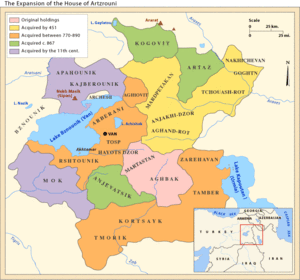- Artsruni
-
History of Armenia 
This article is part of a seriesPrehistory
2400 BC - 590 BCName of Armenia Hayk Hayasa-Azzi Nairi · Urartu Antiquity
591 BC - 428 ADOrontid Armenia Kingdom of Armenia Kingdom of Sophene Kingdom of Commagene Lesser Armenia Roman Armenia Dynasties: Orontid · Artaxiad · Arsacid Middle Ages
429 - 1375Marzpanate Period Byzantine Armenia Sassanid Armenia Arab conquest of Armenia Emirate of Armenia Bagratid Armenia Kingdom of Vaspurakan Armenian Kingdom of Cilicia Zakarid Armenia Dynasties: Bagratid · Rubenid · Artsruni Foreign Rule
1376 - 1918Persian · Ottoman · Russian Armenian Oblast Armenian national movement Hamidian massacres Armenian Genocide Contemporary
1918 - presentDemocratic Republic of Armenia Armenian Soviet Socialist Republic Nagorno-Karabakh War Republic of Armenia
Armenia Portal
Artsruni (Armenian: Արծրունի; also transliterated as Ardzruni) was an ancient Armenian noble family that claimed descent from Sennacherib, King of Assyria (705 BC–681 BC). Although it mirrors the Bagratuni claim of Davidic descent and the Mamikonian claim of descent from the royal Han Dynasty, it is usually interpreted as a piece of genealogical mythology. The origin of this claim is attributed to Moses of Chorene according to whom Sennacherib's sons fled to Armenia after murdering him and founded the clans of the Artsruni and Gnuni. Chorene in turn was in all likelihood inspired by Biblical tradition:
“ "And it came to pass, as he was worshipping in the house of Nisroch his god, that Adramelech and Sharezer his sons smote him with the sword; and they escaped into the land of Armenia, and Esarhaddon his son reigned in his stead." (Isaiah XXXVII, 38)[1] ” Genealogist and historian Cyril Toumanoff favors an Orontid origin of the Artsruni family.[2] Professor James Russell proposed the idea that the Artsrunis derived their name from the Urartian word artsibini (eagle) which survived in Armenian as artsiv (արծիվ). The eagle was a totemic animal for the Artsrunis and in a legend the progenitor of the Artsrunis is said to have been abandoned as a child but rescued by an eagle.[3]
The first attested member of the family is thought to be Mithrobarzanes in 69 B.C, the viceroy of Tigranes the Great in Sophene.[2] During the reign of the Arshakuni, the family ruled the princely estates of Greater and Lesser Aghbak in Vaspurakan, southeast of Lake Van, gradually annexing the surrounding territory.
In the middle of the 4th century the family was deposed. Chavash survived, and recovered power. In 369 the state was led by Merujan Artsruni who guided Persian troops to Armenia and defeated the General (sparapet) Mamikonian. The latter recovered power soon after, however, and Merujan was killed.
Around 772 the Artsruni presided over the families of Amatuni, Rshtuni, Teruni of Dariunq (before a possession of the Bagratuni) and ruled the regions of Maku, Artaz, Great Zab Valley and Van river. In 908 they forged the principality of Vaspurakan.
In the beginning of the 11th century the Artsruni settled westwards in Cappadocia, retreating from eastern invaders. In 1021 Senekerim Artsruni was given Amasia (?), Sebaste and Evdokia as fiefdom from the Byzantine emperor.[4]
Trivia
Umberto Eco introduced the character of Ardsruni, a nobleman and alchemist in Cilicia, in his fantastic novel Baudolino.
Notes
- ^ Kurkjian, Vahan (1958). "A History of Armenia". http://penelope.uchicago.edu/Thayer/E/Gazetteer/Places/Asia/Armenia/_Texts/KURARM/7*.html. Retrieved 2008-02-16.
- ^ a b Toumanoff, Cyril. "ARTSRUNI". Encyclopaedia Iranica Online Edition. Archived from the original on 2007-10-15. http://web.archive.org/web/20071015212808/http://iranica.com/newsite/articles/v2f6/v2f6a030.html. Retrieved 2008-02-14.
- ^ Hovannisian, Richard G. (1997). The Armenian people from ancient to modern times: from antiquity to the fourteenth century. Palgrave Macmillan. pp. 19–36. ISBN 0-312-10168-6.
- ^ Arshag Alboyadjian: "History of the Armenians of Evdokia" New Star Publishing House, Kairo, 1952, p. 187, original title: Պատմութիւն Եւդոկիոյ Հայոց. Տեղագրական Պատմական Եւ Ազգագրական Տեղեկութիւններով:
Categories:- History of Armenia
- Armenian noble families
Wikimedia Foundation. 2010.

